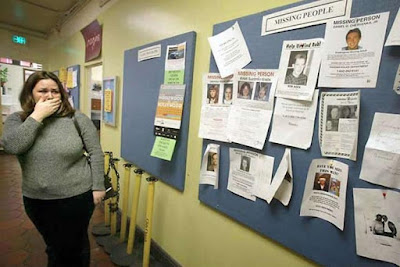 |
| Add caption |
 |
Known by his friends as the “Zombie Hunter,” Bryan Patrick Miller, 46, began his death penalty trial on October 14, 2019, in Phoenix, Ariz. Charged with the 1992 and 1993 murders of Angela Brosso and Melanie Bernas, investigators wonder if there could there be more victims.
Miller was arrested at his North Phoenix home on January 13, 2015, ending a search for a killer that haunted the Valley for more than two decades.
The Victims
Angela Brosso, 22, grew up in Camp Hill, Pa., outside of Harrisburg. Friends and family describe her as “happy go lucky” and fearless. “She was a force,” her mother Linda told E.J. Montini, a columnist at the Arizona Republic. “One of the things her father said about her was that she changed the nature of a room when she entered it. And it’s true, you know? She really did.”
She was a shy little girl who always wore dresses, with long blonde hair her mom would put in buns, pigtails and French braids. Her mom called her Angie.
Angela was an adventurer and an animal lover. In high school, Angela worked at Kentucky Friend Chicken and would spend everything she made on her guinea pigs and bunnies.
During a careers-day program in high school, Angela saw a presentation from a representative at DeVry Institute and enrolled in their school in Newark, N.J. for two years. She then transferred to the DeVry in Los Angeles and graduated with honors. Shortly thereafter, Angela accepted a job at Syntellect, a Phoenix electronics company and moved to North Phoenix where she resided with her boyfriend at an apartment complex located at I-17 and Cactus Avenue.
Angela would be nearly 50 now, had gone out for an afternoon bicycle ride in late 1992, along a bike path that snakes through the city along the Arizona Canal. Her nude and mutilated torso was found in a dirt field near her apartment complex. Her head discovered several days later, about a mile from her home, floating in a canal grate near Metro Center.
With Phoenix Police Department’s best working her case, it would come to haunt them throughout the years.
“Every homicide is a tragedy, but I can honestly say this was one of the most horrific murders to ever occur in the history of this city,” now-retired Detective Leo Speliopoulos told the Arizona Republic.
Though Speliopoulos has never said what evidence was collected at the scene, he has clearly stated what wasn’t found: No witness, no description of a suspect, no weapons, no belongings, and no bike.
Ten months after Angela Brosso’s murder, the body of Melanie Bernas was found floating in the Arizona Canal not far from where Angela’s body had been found.
Melanie Bernas was a junior at Arcadia High school and described as the “girl next door” with dreams of becoming a doctor. She was an achiever who had visits with Pepperdine University and the University of California-Berkeley scheduled just weeks after her death. Her friend Daphne Marcus told the Arizona Republic that she grew up just up the street from Melanie and would ride bikes, have sleepovers, and jump on Melanie’s trampoline growing up.
Melanie was found near I-17 and Dunlap on September 21, 1993. She had been stabbed several times; a turquoise bodysuit lay nearby. Her mountain bike - missing to this day.
Police later linked the two murders. To snare the perpetrator, police entered the DNA profile collected at the scene into the Federal Bureau of Investigation’s Combined DNA Index System (CODIS) – and waited.
Police followed hundreds of tips over the years, even placing street signs along the path near where the bodies were found. Local reporters worked for years on stories to remind the public the murders were still unsolved.
Police revisited the case over and over throughout the years, accumulating enough files to justify its own cabinet.
Police enlisted the help of the Vidocq Society, an organization consisting of forensic experts who dedicate their time to solving cold cases to develop a profile of the man who would likely be their killer. Analyzing the cases, Vidocq predicted the man would still be living in the general area of the murders and would have committed precursor crimes. A man who possibly acted out fantasies and set fires. Vidocq detectives also said it was possible police had crossed paths with the individual earlier in the investigation.
When police circumnavigated the case files, they found Miller who, as a juvenile, had been arrested in the stabbing of a woman at Paradise Valley Mall in 1990. A precursor event that supported Vidocq’s predictions.
Miller told police he stabbed the woman because she reminded him of his mother.
Throughout the years Miller had avoided detection by police because his DNA profile had not been entered into CODIS, the national DNA database that cross-references DNA samples from crime scenes with convicted felons.
Phoenix Police Sergeant Trent Crump said Miller had been interviewed when the murders occurred, but there was no physical evidence tying him to the case.
In the weeks before the arrest, police had been surveilling Miller and, using a ruse, collected his DNA. Crump would not say what kind of ruse was used but admitted that it is relatively simple to obtain DNA from items people discard.
Who is Bryan Patrick Miller?
Bryan Patrick Miller is described as quiet by his landlady but went on to say he wasn’t a good tenant and rarely paid his rent on time. She explained the reason she didn’t kick him out was because of her affection for Miller’s 15-year-old daughter, Sarah.
Other renters described him as a shy and a not “quite normal” young man who would dress up in Cosplay, who drove an old decommissioned police car with lights on top and prominent sticker on the trunk reading Zombie Hunter.
Miller marketed himself as the Zombie Hunter on Facebook and other social media platforms, offering to make appearances at zombie walks and comic bookstores. Miller’s Facebook photographs feature the macabre and reflect a wide range of hobbies to include the fantasy subculture, steampunk, and Comic-Con.
On another popular website called DeviantArt, artists can upload their work and share it with the public. Like Facebook, fans of the art site would “like” the photographs. Miller chose to like some of the most frightening images consisting of women who were decapitated or horrifically mutilated.
Miller lived with his daughter Sarah and was a member of the Mennonite Church. Ironically, Mennonites are non-violent and tend to oppose violence and war.
Court records indicate Miller had petitioned for full custody of his daughter in 2008, claiming Sarah was suffering from health problems living with her mother who Miller claimed was homeless and unemployed.
The Arrest
On January 14, 2015, over 25 years after the gruesome murders of Melanie Bernas and Angela Brosso, police arrested Miller, 42 at the time, as a suspect after getting a DNA match using genealogy software.
According to court documents, Miller denied involvement in the murders but had no explanation of how his DNA matched the profile found on the victims. Miller told police that he lived near the bike path and admitted to frequently biking the path.
Police say they are not ruling out the potential that Miller could be connected to other Valley murders. Crump said Miller had moved to Hawaii and Washington prior to returning to Phoenix. Phoenix investigators are continuing to work with other state agencies analyzing unsolved murders for any connections. Crump told the Arizona Republic that it would be “very unusual” if Brosso was Miller’s first victim and Bernas his last.
When police made the arrest at Miller’s home on Ninth Street and Mountain View Road, one could see officers carrying out numerous boxes of items and even a bicycle.
When investigating the scene, police described Miller as a classic hoarder. “Floor to ceiling, it was packed with all sorts of junk – boxes to paper to furniture – I can’t even tell you what wasn’t in there,” said Crump.
Are There More Victims?
Reports obtained by ABC 15, revealed Miller’s own mother called Phoenix Police out of the blue to tell them her son had a strange obsession with Angela Brosso’s case over the years.
Miller’s ex-wife also made claims there may be more victims. In 2015, police released new details in the case that all but confirm those suspicions.
Brandy Myers
Brandy Myers, 13, vanished on May 26, 1992, while knocking on neighborhood doors raising money for her school’s book club. She just so happened to live in the same neighborhood as Miller.
Brandy’s sister Kristin Thelen describes her sister as having diminished mental capacity and very trusting. “So, we walked by him every single day. We had no idea we were living by this monster,” said Thelen. “He lived three blocks from my house and one block from our school.”
Police now believe Miller’s house was the last door Brandy knocked on. “I will tell you that he is a very strong investigative lead in the investigation,” said Crump. In fact, Phoenix police filed a first-degree murder charge against Miller in the disappearance of Brandy. However, the county attorney declined prosecution, stating there was “no likelihood of conviction.”
Miller’s ex-wife Amy’s interviews with police revealed that Miller had confessed to Brandy’s murder decades ago saying, “He grabbed her and dragged her into the house,” Amy told Crime Watch Daily. “At the time I truly believed he was just making up the story.”
Thelen recalls the day Brandy disappeared. “I was supposed to go with her,” said Thelen. “He pulled her into the house, killed her, dismembered her, and threw her body out in the trash,” said Thelen.
Thelen is calling for Miller to confess to the crime. Brandy's body has never been found and Phoenix Police say the investigation is ongoing.
Adrienne Salinas
On June 15, 2013, Adrienne Salinas, 19, was walking to a local gas station to get a cab. Somewhere between her apartment and the station only a quarter-mile away, she vanished.
Adrienne was living in Tempe, Ariz., and attending community college. Her friends talk about her smile and how she was soft-spoken, describing her as one of the sweetest and nicest people they have ever met.
Out on her own for the first time, she lived with two roommates. She also had a job but had been unable to work after suffering from Valley Fever and undergoing lung surgery.
The night she disappeared; Adrienne had left a party that she attended with several friends. That evening, police received a 911 dispatch call reporting a car driving erratically on First Street and had just hit a curb and had two flat tires. The vehicle plate matched Adrienne’s vehicle.
Adrienne had abandoned her car just a few blocks from her apartment. She sent a text to her boyfriend at 4:43 a.m. that she was coming over. Ten minutes later, she called for a cab.
By 5:07 a.m. she either turned her phone off or it went dead and so did her trail.
On August 6, Adrienne’s body was found in a wash in Apache Junction near the Superstition Mountains, 30 miles away from where she was last seen.
There had been a storm with 6 feet of rushing water going through a wash. When the water receded, her remains were found.
DNA confirmed is was Adrienne but in the medical examiner report, it doesn’t mention her head or hands, stating the remains were mummified, mostly just bones. Many questioned if she had been decapitated.
After learning about Adrienne’s condition, Keene Azariah went to Tempe Police and suggested they look at his friend Bryan Patrick Miller.
Azariah claimed he and Miller had attended a party together a mile away from Adrienne’s apartment on the same weekend she vanished. Her body was also found close to where Miller regularly participated in Steampunk and Cosplay activities.
“If you consider that he’s under investigation for murder and he’s a mile away from our case, it’s definitely on our radar,” said Detective Akey of Tempe Police Department. “He’s under investigation for this case, yes. Another person we would like to have a conversation with.”
Tempe Police say the murder of Adrienne is an ongoing investigation.
Shannon Aumuck
Shannon Aumuck, 16, resembled Brandy Myers and vanished when she ran away from a group home not far from Brandy Myers North Phoenix neighborhood. She was never reported missing.
Her body was found on May 27, 1992, in the north valley and remained unidentified until 2011. She had been buried as a Jane Doe at Twin Buttes Cemetery in Tempe until her body was exhumed on March 22.
Shannon was classified as a “throwaway child” who lived her life in foster care under Child Protection Services (CPS). She was a chronic runaway who had behavioral problems and contact with police constantly. According to police, between 1989 and 1991 it was reported she ran away at least 40 times.
Shannon’s birth has been a result of a sexual assault to a 16-year old mother and adopted out to a family who lived in Flagstaff and later moved to Scottsdale. Because of Shannon’s out of control behavior they gave her back to CPS when she was 12.
Her body had been found in a trash pile by an ATV rider in the rural area of 26th Street and Deer Valley Road. “She was tossed aside in death as she was in life,” Detective Stuart Somershoe told the East Valley Tribune.
Somershoe and his colleague Will Anderson took over the case in late 2010. They soon found Shannon’s birth mother still lived in the Valley and collected a DNA profile from her. The two then began reviewing 1,600 reports on runaways between 1991 and 1994 hoping to identify the girl which eventually led to an unidentified girl buried in the Tempe cemetery. Shannon’s cause of death was strangulation.
Police continue to investigate Shannon’s murder and hope they can provide answers for both Brandy and Shannon’s families. “Nobody who dies should ever go as unidentified,” Somershoe said. “Everybody has a mother; everybody has a brother. The good news is that we have identified her. The bad news is we still have a child murderer on the loose.”
|


























